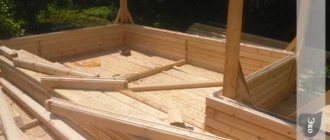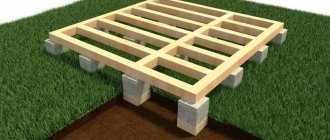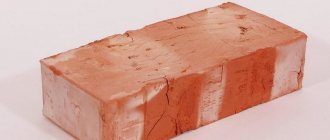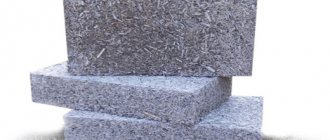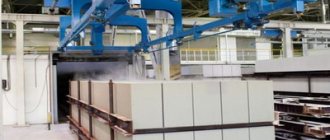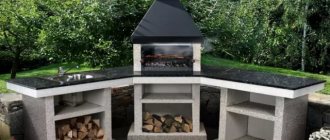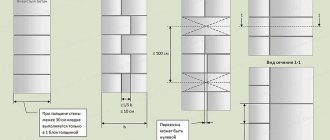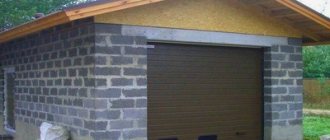To find out how many cinder blocks are in a cube, just perform a simple calculation. It is carried out before the start of work, when products are purchased individually or by cubic meters. Typically, cinder blocks are sold on pallets, the number and volume of which depends on the type of product and the weight of one unit of goods.
As part of a project for the construction of any facility, an estimate is developed that takes into account the volume of work. Brick and cinder block masonry in this case are measured in cubic meters. The number given in the document is not always an integer, which causes certain difficulties in calculation. Then it is necessary to determine the number of slag concrete blocks not only in 1m3, but also in 1m2, because Exterior and interior finishing is characterized by a different unit of measurement.
If the project is being developed by a construction company, you can turn to it for help. The specialists themselves will calculate how much material is needed and advise which store is best to contact. If you develop a construction project yourself, you will have to manually calculate the amount of required building materials. A construction estimate is most often a custom document drawn up by a specially trained person—an estimator. The estimate contains information not only about the scope of work, but also its cost. The latter is not the only correct one, because depends on many factors. In this case, when calculating cinder block masonry, the quality of cement introduced into the cement-sand mortar, the cost of additives, the presence of reinforcement, etc. are taken into account.
To calculate the amount of cinder block in 1 m³, you need to take into account several features:
- There are several types of slag concrete block, which differ in purpose and size, as a result of which its quantity varies in 1 m² and 1 m³. When using different types of products (facing, standard, partition) you will need different amounts of material.
- A slag concrete product consists of blast furnace slag, crushed cement, granulated screenings or crushed stone, and cement is used as a binder. The composition does not affect the amount of product in 1 cubic meter, but changes its mass. This should be taken into account when transporting the calculated amount of material to the work site. Also an important factor is the presence of voids in the product.
- Cinder concrete blocks can be made at home, in which case the dimensions may differ slightly from the dimensions of industrially produced products. Here it is necessary to take into account the average lengths of the sides of the building material in order to determine how many cinder blocks are in the cube.
- The dimensions of the standard block are 390x190x190 mm. When calculating, these dimensions increase slightly and are taken as 400x200x200 mm, this is due to the presence of a solution with a thickness of at least 10 mm between the blocks.
How to calculate the number of blocks in 1 m³?
Cinder block calculations are made using simple formulas. First you need to calculate the volume of one product (V) by measuring its length (L), width (W), height (H) and multiplying these values:
V=L*W*H (cubic meter)
It is better to substitute dimensions in the formula in meters; this will not lead to errors in further calculations.
To find out how many cinder blocks (N) there are per 1 m³, you need to divide this number by the resulting volume:
N=1/V (pieces)
These formulas are universal; they will allow you to accurately calculate the amount of cinder block in any volume accepted on the basis of the estimate. With their help, you can also determine the amount of material to build a cinder block house, an extension to it and other objects.
Calculation example
How many standard cinder blocks are in one cube?
Let's determine the volume: V= 0.4*0.2*0.2=0.016 cubic meters.
Let's determine how many cinder blocks are in one cube: N=1/0.016=62.5 pieces.
That is, one m³ contains 62.5 pieces of slag concrete block. The estimated amount of cinder block per house, measured in cubic meters, must be multiplied by the number of products per 1 m³. As a result, we get the total amount of material needed for construction.
When calculating, it is worth paying attention that the resulting amount must be increased by 10-15%. This will eliminate the shortage of building materials in case of detection of defects, damage to blocks during construction, etc.
Why do you need to count the number of cinder blocks?
Having correctly calculated how many cinder blocks there are in a cube, you can move on to the economic part of construction, and calculate how many cubes of material will be required for the construction of the object under construction.
The specified formula for calculating the amount of building material in one cube is used for a wide variety of materials sold in cubic volumes. The formula allows you to calculate the required amount of materials for construction, accurate to one.
Considering the rather high cost of modern building materials, such a careful calculation of the number of cinder blocks required for construction is a mandatory and very important procedure that allows you to save the owner’s finances.
- Gas block and foam block, the difference
How many cinder blocks are there in 1 m²?
How to calculate the number of concrete blocks per square meter:
- Calculate the base area of the cinder block: S=L*W (square meter).
- Determine quantity: n=1/S (pieces).
Using these formulas, you can determine how many cinder blocks in 1 standard pallet are on the same level. During transportation, the blocks are placed close to each other, this preserves their integrity, eliminates mechanical damage and reduces the dimensions of the cargo. However, pallets are not manufactured in 1 m² size, they are standard and have a size of 1.2 x 0.95 m.
Calculation example
How many standard cinder blocks are there in 1 m²?
Base area: S=0.39*0.19=0.0741 m².
Quantity: n=1/0.0741=13.5 pieces.
With standard pallet sizes, the first tier contains: m=1.2*0.95/0.741=15 pieces.
How to calculate a cinder block?
To calculate, we need to know only one value - the volume of one block. Calculating the volume is very simple; there is a formula for this that everyone should know:
V (volume) = L(length) x B(width) x H(height)
We measure the dimensions of one cinder block, namely length, width and height and multiply them. We will measure dimensions in centimeters. One cubic meter is 1,000,000 cubic centimeters.
Let's do the calculation. Let's say we have a block with dimensions 40cm x 20cm x 20cm. Its volume (V) will be equal to:
V = 40x20x20 = 16000 cm3
To find out how many cinder blocks are in a cube, perform the division operation:
1,000,000 cm3/16,000 cm3 = 62.5 pcs
For clarity, let's calculate how many partition cinder blocks are in 1 m3. Its dimensions are 400x200x120 mm. We convert millimeters to meters and get 0.4x0.2x0.12 m. We multiply these dimensions and get the volume of one partition block:
0.4x0.2x0.12 m = 0.0096 m3.
Now we do the division:
1 m3 / 0.0096 m3 = 104.17 pcs.
So we have calculated everything. Cinder blocks can be made in different sizes; by substituting them in the formulas above, you can quickly calculate everything.
For transportation, the blocks are placed on pallets and usually there are more or less than a cube (the exact volume is indicated on the packaging). For construction, materials are always purchased from a reserve of 5-10%. This must be taken into account when calculating.
Advice from professionals
- To calculate how many blocks there are in 1 m³, you need to take dimensions of 0.4x0.2x0.2 m. This will provide more accurate results. When calculating the amount of building material per 1 m2, you need to take the actual dimensions of the product without taking into account the thickness of the concreting joints.
- Depending on the type of slag concrete block, its quantity on the pallet may differ. The standard packaging contains 75 elements of a hollow block or 45 elements of a solid block. The total weight of the product on the pallet should not exceed 1 ton. The weight of a solid block is 20 kg, a hollow one - 13 kg.
- When choosing a building material, it is necessary to determine the required properties in advance. The hollow product has lower thermal conductivity due to the presence of air chambers, which ensures that it remains cool in summer and warm in winter. The solid product is characterized by increased sound insulation.
- The number of cinder blocks in 1 cube depends on the type of product. The standard block has dimensions of 0.39x0.19x0.19 m³, partition - 0.39x0.19x0.12 m³, facing - 0.39x0.19x0.09 m³.
- When making a mixture for laying cinder blocks, a cement-sand mortar with the addition of glue or various plasticizers is used. This ensures greater adhesion of surfaces, mobility of the mixture over a long period of time and rigidity of the hardened solution.
Using the above formulas, you can easily determine how many cinder blocks are needed in pieces for the specified amount of work. In order not to buy too many building materials, it is enough to use basic calculations. This will eliminate additional costs for the purchase of the product itself, as well as its transportation.
Pros and cons of cinder block
Advantages:
- Good geometry - the cinder block has good geometry and even with a slight deviation there will be nothing bad, since the laying is carried out on a cement-sand mortar 1 cm thick. This, in turn, compensates for small deviations in geometry.
- Ease of operation - no need for highly qualified workers, such as, for example, when laying bricks.
- Speed of construction - due to its considerable size, construction from cinder block is much faster than from brick.
- Visual appeal - you can build from blocks for finishing with subsequent grouting or grouting thanks to the even and smooth edges of the block. But here you need to remember that it is impossible to leave the block; it must be hydrophobized, since it is destroyed under the influence of moisture.
- Relatively low cost due to the low cost of cinder block components compared to brick and gas block.
Flaws:
- High thermal conductivity - a house made of this material will quickly lose heat in winter and heat up in summer.
- Difficult to process - the stone is quite hard in comparison with aerated block or shell rock.
- Large weight - one block weighs from 22 to 28 kilograms, depending on the percentage of voids.
- It is not radioactively safe - it can emit radiation due to a filler such as blast furnace slag. Therefore, when purchasing a stone, it must be checked for radioactivity!
- Not environmentally friendly - industrial waste is used in its production.
- Low frost resistance – F15-F35.
- It is destroyed by moisture - therefore it needs protection, for example, plaster and proper waterproofing between the wall and the foundation.
- Poor adhesion with cement-sand plaster - there is a possibility of the plaster peeling off, so you always need to use a plaster mesh, and this is an additional cost.
- Poor sound insulation – additional measures are needed to soundproof the building.
What is a cinder block? It is a building stone that is widely used in modern construction. Load-bearing structures, interior partitions, and lightweight foundations are erected from this material. Cinder blocks are used in private and commercial buildings. However, rumors persistently circulate on the Internet about the harmfulness and unreliability of this building material.
Let's try to understand all the characteristics of cinder blocks, separate truth from fiction and find out what it consists of.
Pros and cons of the material
Like any building material, cinder block has advantages and disadvantages. To the benefits
The following features include:
- Economic expediency.
Durability and sufficient strength of the material for low-rise construction.
Light weight and, as a result, reduced load on the foundation.
Neutrality to any microflora: the risk of wall contamination by fungus or mold is zero.
Fire safety: ignites only in a blast furnace; such temperatures are impossible in a normal fire.
Ease of use: the material is lightweight, so construction work can be carried out by one person.
Simplicity: if desired, can be made at home.
If we talk about the disadvantages, the following negative factors
:
- There is a possibility of purchasing material that does not meet environmental standards. Require certificates!
When manufactured independently, the characteristics of the blocks may differ significantly.
The building looks visually unattractive. The issue is resolved by additional external cladding.
If the block filler has an organic base (for example, sawdust), then the actual service life of the structure may be lower than the calculated one.
The material absorbs moisture, which requires additional costs during construction: insulation, external wall cladding.
There is an opinion that it is not intended for multi-story buildings, but in some regions (for example, Yakutia) 5-story buildings erected during the Soviet era still stand safely to this day.
A cinder block is lighter and warmer than a sand block, stronger than a foam block. A detailed answer to the question: “Which material to choose” will require a separate article. In this material we will make a brief comparison of cinder block with other types of materials that are often used in modern construction.
Cinder block or gas block
If we compare the characteristics of these materials, the gas block has better thermal insulation and soundproofing. In addition, aerated concrete blocks have high strength, which makes them possible to use in multi-story construction. If we are talking about private buildings, there is no significant difference between the materials, except that aerated blocks can be used in regions with high air humidity, and cinder blocks are better suited for areas with a dry climate.
Cinder block or foam block
These materials have only two significant differences that set foam blocks apart: environmental safety (confirmed by certificates) and resistance to humid environments. Otherwise, the materials are identical, although they differ in production technology.
Which is cheaper?
Based on the building materials under consideration, the most budget-friendly would be cinder block. In fact, this stone is made from industrial waste, which determines its low cost.
Number of bricks in one pallet
Despite the abundance of fundamentally new building materials, traditional brick still remains one of the most popular and relevant options for laying walls and building individual houses. Bricks are sold in pallets, which greatly facilitates their storage, transportation and loading. But most private developers prefer to calculate the volume of purchases individually. In addition, quite often manufacturers set the price not per unit of goods, but per pallet. Therefore, in order to know the full cost, it is necessary to correctly calculate how many bricks are in the pallet.
Brick and its varieties
In order to calculate the amount of material that fits in one pallet, you should understand which type of material needs to be purchased in a particular case. Depending on the raw materials used, silicate and red bricks are distinguished. According to its structure, it is:
- Full-bodied.
- Hollow.
- Facing.
Red.
Red brick is predominantly used in the construction of houses and cottages. It is made from various types of clay by firing. It is quite durable, not too heavy (solid weighs approximately 3.6 kg, hollow - 2.5 kg) and successfully withstands harmful atmospheric influences. The standard size is 250 x 120 x 65 mm.
No less popular is silicate briquette, which is produced by autoclave from sand with various additives. This type has excellent heat and sound insulation properties, as well as high frost resistance. The weight of the product is slightly larger - a solid one weighs 5 kg, a hollow one - no more than 4.
Number of blocks in a pallet
The capacity of the platform depends on the size of the bricks laid on it, as well as on the dimensions of the platform itself. There are single, one and a half and double bricks. In all cases, the dimensions of the product remain unchanged, only the height differs:
- for single – 6.5 cm;
- for one and a half – 8.8;
- for double – 10.3.
As for pallets, they come in two types:
- standard – 103 x 52 cm, load capacity – 750 kg;
- reinforced – 103 x 77 cm, load capacity – 900 kg.
Knowing the weight of the material, as well as its main parameters, you can calculate how many pieces the platform can hold. To do this, the area of the base is divided by the area of one product. By multiplying the resulting number by the number of rows on the pallet, we find the total amount:
- no more than 420 pieces if it is a single brick;
- about 390 units if it is one and a half;
- up to 200 doubles.
Such calculations will not be suitable if the installation on the base took place at an angle of 45 degrees - “herringbone”. In this case, you can find out the number of blocks using simple geometry, namely by counting in one cubic meter.
The information obtained allows you to optimize costs. The price of wall material, which makes up a significant share of the total cost of building a house, does not allow you to buy it “just in case.” In addition, excessive quantities will increase the cost of transport and loading.
Pricing is influenced by the following points:
1. brand and country of origin;
2. technical characteristics and dimensions;
3. strength and ability to withstand many freezing cycles;
4. distance from the construction site.
| Name | Single | One and a half | Double |
| Red Private | 9 | 11 | 14 |
| Brown | 15 | 23 | |
| Silicate private | 11 | 12 | 14 |
| Facing | 19 | 20 |
